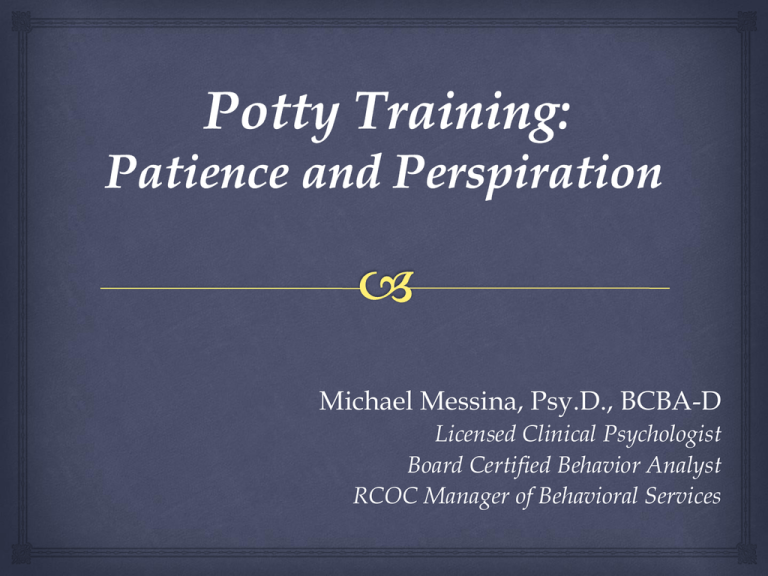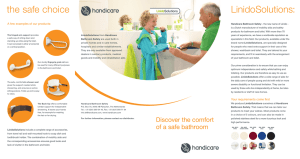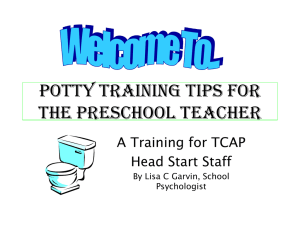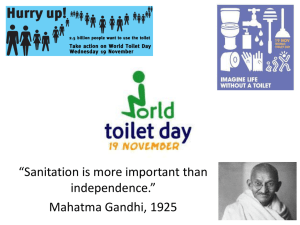Potty Training – Patience & Perspiration
advertisement

Michael Messina, Psy.D., BCBA-D Licensed Clinical Psychologist Board Certified Behavior Analyst RCOC Manager of Behavioral Services The Truth about Toilet Training It is extremely difficult It is a dirty job It is not for everyone It may be easier for parents NOT to toilet train their child It can take a REALLY LONG TIME It takes a HUGE commitment from caregivers It is an inconvenience It could lead to other problem behaviors It may be an ongoing process for maintenance However, toilet training your child may… Save parents time (in the long run) Lessen parent stress Save parents money Be more convenient across various settings (i.e. community) Enable the child to have more independence Enable the child to have a better social life Increase the child’s confidence Make the child and family happier Toilet training your child requires you to… 1. Get knee deep in it 2. Get your hands dirty 3. Dive in head first “GET KNEE DEEP IN IT” Toilet training requires a thorough understanding of several aspects related to toileting: Biology Cognitive functioning Fine motor skills Antecedents Consequences Topography of toileting routine Times, locations, and frequencies History “GET YOUR HANDS DIRTY” Parents must take a “Hands On” training approach. This is active participation in helping the child with the toileting activity, changing the child, and/or being in the bathroom with the child. “DIVE IN HEAD FIRST” Toilet training really requires USING YOUR HEAD and being able to think on your feet. Intervention strategies will be different for every child. Intervention may change throughout training. Toilet training requires creativity. Five P’s of Potty Training Priority Preparation Practice Participation Program Priority It is important to know when a child is ready to be toilet trained. While all that is listed may not be necessary to attain success, certain skills increase the likelihood of successful toileting. Follow simple instructions Developmental age of two Able to pull up/down his/her pants Can stay dry for a few hours at a time Priority (cont.) Shows some awareness of being wet Dislikes being wet Awareness of having a BM or urination (i.e. withdrawal, body positioning) Regular BMs and no soiling during sleep Stool should be normal in size and consistency. Soft, well-formed bowel movements are recommended. Should be no evidence of constipation or diarrhea. Child’s diet or medications may be a factor in stool formation. Contact medical doctor if stool withholding occurs Priority (cont.) Able to sit and hold body on toilet (may need adaptations) No medical conditions or medication that make toileting impossible (may need medical evaluation) Communicates need to use the bathroom or need to be changed Preparation Prepare your child Model toileting for the child Let the child observe parents or siblings using the toilet Watch a DVD of toilet routine Read books on toileting Toileting dolls 12 Preparation (cont.) Potty Training DVDs Preparation (cont.) Potty Training Books Preparation (cont.) Make toileting a comfortable experience. A step stool so feet are not dangling and so that he/she is able to get on the toilet independently A potty chair or adaptive seat Make the room and toilet seat temperature comfortable 15 Preparation (cont.) Make toileting a fun and pleasant experience Have a favorite book or toy in the bathroom that the child only has access to while in the bathroom Have music or a portable DVD player on while child is sitting on the toilet Make a game out of toileting (i.e. sinking the Cheerios, lining the toilet with foil to make a noise) Keep bathroom organized and clean to reduce distractions 16 Preparation (cont.) In most cases, once you begin toilet training you should put away diapers and only use pull-ups or underwear Have fun underwear with cartoon characters Place underwear under pull-up so that child feels the wetness Pull-ups should be slowly faded and underwear only should be used If having a diaper or pull-up on is an antecedent to elimination, then a hole may be cut in the diaper and the child then placed on the toilet and prompted to go 17 Preparation (cont.) A graduation ceremony may be held to teach the child that he/she has graduated from pull-ups and is a big boy/girl now that uses underwear. This ceremony may be important to have when beginning a toileting program Child should wear clothes that are easy to pull down Avoid snaps, buttons or zippers that may be too difficult for your child to undo 18 Practice Address toilet sitting refusal Utilize appropriate strategies to address other behavioral concerns related to toileting tasks (e.g., tantrums, physical aggression, etc.). “Rewards with shaping” may be utilized to help child approach and sit on the toilet for a longer time (i.e. start with 10 seconds, then go to 20 seconds, etc.). A timer may be used. Don’t make your child sit for too long 19 Practice (cont.) Keep your language simple and consistent All caretakers should use the same words, such as “pee-pee” or “poo-poo” Use short simple phrases, such as “sit on toilet” or “go pee-pee” Remain neutral if your child has an accident. Do not utilize punishment or negative reactions if your child has an accident. Remind him/her that pee or poo goes in the toilet 20 Practice (cont.) Utilize a Task Analysis May want to sequence the steps involved in toileting in a series of photos or pictures Review this with your child before, during and after toileting 21 Practice (cont.) Task Analysis 22 Practice (cont.) To increase the likelihood that your child will let go while on the toilet: Provide your child with water 15 minutes before toileting prompt Turn on running water in bathroom Sit your child on the toilet according to his/her typical elimination pattern 23 Participation Don’t make toileting an aversive task Don’t force your child If your child is not ready you may need to wait a few weeks and then reintroduce the subject Forcing your child will make the experience more aversive and he/she may develop a fear of toileting Do not flush the toilet while your child is still on the toilet 24 Participation (cont.) Have your child participate in the cleanup/changing process Have him/her clean up if possible Have him/her throw away dirty diaper Have him/her pull up his/her own pants Have him/her empty own diaper into toilet Complete all toileting activities in the bathroom Don’t make it fun! 25 Program Take data on a “Toileting Schedule” Establish baseline and notice patterns Maintain a toileting routine based on data collected Remember the natural opportunities for toileting, such as upon waking up, before bathing, before a preferred activity, before leaving the house or transitioning, and before going to sleep A timer may be used 26 Program (cont.) Rewards should be used for dry/clean pants, urination on toilet, and/or BM completion on toilet A visual monitoring system is recommended Use self management if possible www.rewardcharts4kids.com www.freeprintablebehaviorcharts.com www.kidpointz.com Program (cont.) Once child is no longer having daily accidents, selfinitiation skills can be targeted. Reward self-initiation to the toilet. Gradually fade out parent prompts. 28 Program (cont.) Bed-wetting: Much of the same interventions apply, however, successful toileting patterns during waking hours is needed before bed-wetting can be addressed Limit amount of fluid child has to drink before bed Have your child void before bed The bell/pad technique Wake child up to use the toilet Rewards can be used for staying dry all night Case Examples What to do when the basics fail… Dale 6 year old male diagnosed with PDD NOS Fully verbal and ambulatory Urinates standing and completes all activities associated with urinating (i.e. initiation, pulling up and down pants, hand washing, etc) independently at home and at school Dale (cont.) Normal BM almost every day in the evening (sometimes every other day) at home in between 4:00pm and 8:00pm. No BMs at school or other places in the community. Wears regular underwear throughout the day. Dale (cont.) Initiates BMs by obtaining a pull-up for himself from the bathroom cabinet. After removing pants independently, he independently places the pull-up on and completes a BM shortly thereafter. The BM sometimes occurs while still in the bathroom, and sometimes occurs after he has left the bathroom. Following BM, he will sometimes resume the activity that he was engaged in prior to the BM (i.e. playing) Dale (cont.) Does not always seem to mind sitting in a soiled pull up, although will sometimes tell his mother that he had a BM. When a parent realizes that he had a BM (e.g., because he tells the parent or because the parent senses the odor), the parent will require that he remove his own pull up, clean himself, place back on his clean clothes, throw the pull-up in the trashcan, and wash his hands. He usually complies with the clean up routine independently following these instructional cues, however, sometimes needs assistance (i.e. parent does it for him rather than hand-over-hand) getting completely clean. What do you do? Marco 7 year old male diagnosed with Autism Mostly non-verbal and fully ambulatory Urination accidents multiple times daily No attempt to use the bathroom or tell his parent that he had an accident Wears a pull up all day, daily. What do you do? Questions? Thank you! Dr. Michael Messina (714) 796-5225 mmessina@rcocdd.com








